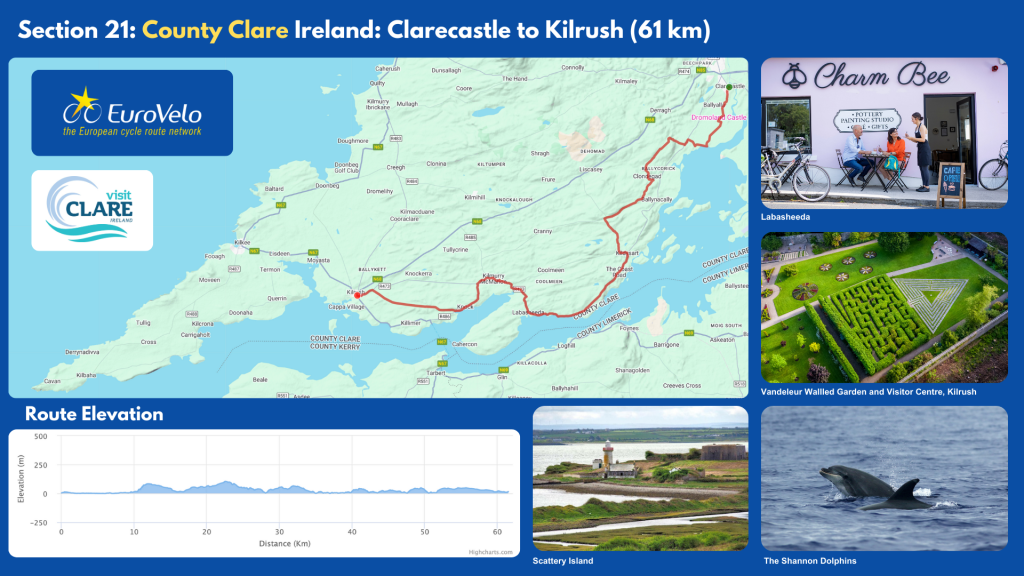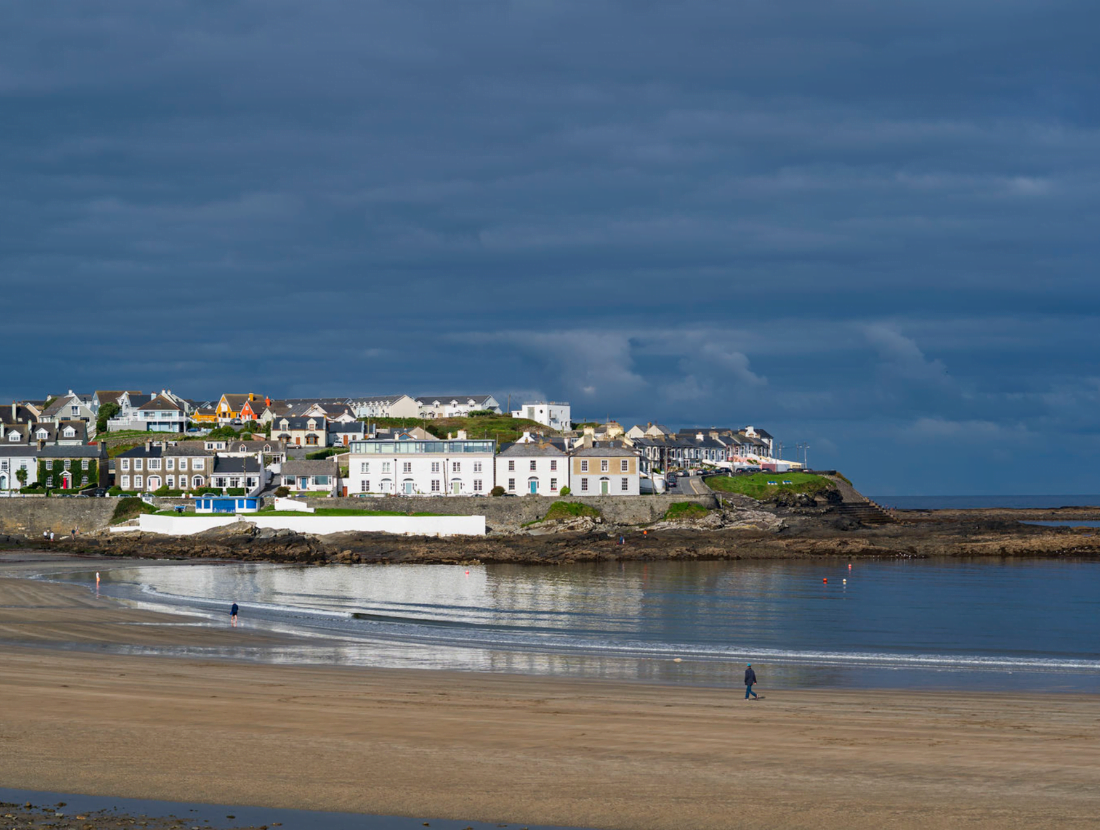
The EuroVelo network connects Europe through 17 long-distance cycle routes. In Ireland, the EuroVelo 1 Atlantic Coast Route spans from County Wexford to County Donegal, offering cyclists a scenic journey along Ireland’s stunning southern and western coastline.
In County Clare, the route covers over 270 km across four daily sections, mainly on quiet rural roads with low traffic. Cyclists can enjoy Clare’s spectacular coastal scenery and a rich blend of natural and cultural attractions along the way.
Below are the four sections:
Section 21: Clarecastle to Kilrush – 62km

Note re Section 21: You can access an interactive map and a downloadable GPX file for Section 21 via the EuroVelo Ireland website here.
Starting in the charming village of Clarecastle, this section of the route invites cyclists to explore the unique beauty of Clare’s landscape as they head towards the Shannon Estuary. Just a stone’s throw from Ennis, you can take a moment to visit the historic Clare Abbey, nestled on the banks of the River Fergus. For those seeking a detour, the newly developed cycle/pedestrian path will lead you directly into the heart of Ennis, Clare’s vibrant capital. Ennis is rich in history and character, with its narrow, winding streets, colourful market town atmosphere, and stunning historic architecture.
Leaving Clarecastle, you’ll soon join the scenic Shannon Estuary Way. This coastal route offers a true sense of escape as it winds through a mix of ever-changing landscapes, from sweeping river vistas to rolling hills. Along the way, you’ll pass through picturesque villages like Ballynacally, and Labasheeda, where rich archaeological heritage is embedded in the streets and landscapes.
As you cycle along, enjoy the tranquillity of the Shannon Estuary and the rural charm that surrounds it. The route continues towards Kilrush, a lively coastal town that’s a perfect base for further adventure. Kilrush boasts a busy market town vibe, but it’s also a gateway to the rugged west coast. Don’t miss a visit to the beautiful Vandeleur Walled Garden, a peaceful oasis in the heart of the town. For those seeking more water-based exploration, Dolphin Watching Boat Trips from Kilrush Marina is a must. A cultural boat trip from Kilrush to monastic Scattery Island offers a unique glimpse into Clare’s fascinating ancient history.
At the end of the section, cyclists can opt for a convenient 20-minute ferry ride from Killimer in Clare to Tarbert in County Kerry, connecting the journey between Clare and Kerry. However, don’t leave Clare too soon – there are 3 other sections to the route!
Section 22: Kilrush to Kilkee – 68km

Note re Section 22: You can access an interactive map and a downloadable GPX file for Section 22 via the EuroVelo Ireland website here.
Leaving the heritage town of Kilrush, you’ll venture deeper into the scenic coastal landscape of West Clare. Kilrush, with its rich maritime history and proximity to Scattery Island, sets the stage for the next leg of your journey.
Heading west, your first stop is the charming village of Carrigaholt, located at the mouth of the River Shannon. This picturesque village is home to the 15th-century Carrigaholt Castle, and it’s also the departure point for dolphin-watching boat trips. These boat trips not only offer a chance to see the resident dolphins but also provide stunning views of the rugged coastline and cliffs surrounding Loop Head. Carrigaholt is a great spot for a relaxing pause, with its deep connection to the sea and local fishing traditions.
Continuing your journey, you’ll follow the road towards Loop Head Peninsula, a truly wild and rugged part of the Clare coastline that epitomises the best of the Wild Atlantic Way. Here, you’ll find the iconic Loop Head Lighthouse, perched on the westernmost tip of the county. The lighthouse is a signature attraction, offering panoramic views of the Atlantic and the stunning cliffs that make this area famous. The tranquillity and vastness of the surrounding landscape make it a perfect stop for contemplation and taking in the raw beauty of nature.
As you cycle on, the route takes you past the Bridges of Ross, a natural sea arch that remains a testament to the Atlantic’s power. It’s an ideal spot for a break to enjoy the dramatic coastal scenery.
The route ends in the seaside town of Kilkee, famous for its safe swimming spots and spectacular coastal landscapes. Kilkee’s Pollock Holes, natural tidal pools formed by the Atlantic, offer a unique and refreshing swimming experience. The Kilkee Cliff Walk is a must-do, offering awe-inspiring views of Bishop’s Island and the Loophead Peninsula. With its golden sands and welcoming atmosphere, Kilkee is a perfect place to relax after your journey through Clare’s wild coastal beauty.
Section 23: Kilkee to Doolin – 73km

Note re Section 23: You can access an interactive map and a downloadable GPX file for Section 23 via the EuroVelo Ireland website here.
Leaving from the scenic seaside town of Kilkee, with its famous horseshoe bay and dramatic cliff views, the route winds along quiet local roads to Doonbeg, a peaceful village offering a range of outdoor activities. Whether you enjoy angling, birdwatching, or just soaking in the serenity of the surroundings, Doonbeg is a perfect stop-off point. The village is also home to the renowned Trump International Doonbeg Links, a golf course known for its world-class play and stunning coastal backdrop.
Continuing onward, the route leads to Milltown Malbay, a town steeped in traditional Irish music heritage. The annual Willie Clancy Music Festival draws musicians and fans from all over the world, bringing the town to life with vibrant sounds. Nearby, the beaches of White Strand and Spanish Point offer stretches of sandy shores and refreshing Atlantic breezes, making them ideal spots for a brief rest along the way.
As you move north, you’ll arrive in Lahinch, one of County Clare’s most beloved beach towns. Famous for its world-class surfing, Lahinch offers plenty of opportunities to rent boards and gear from local surf schools, catering to both beginners and seasoned surfers. For those interested in golf, the Lahinch Golf Club is a must-visit, offering a spectacular course with sweeping views of the coastline. The town’s lively social scene and warm atmosphere make it a wonderful place to enjoy a well-deserved break.
Cyclists also have the option to take a detour to the awe-inspiring Cliffs of Moher, one of Ireland’s most iconic natural wonders. Rising over 200 metres above the Atlantic Ocean, the Cliffs provide stunning, panoramic views and are an essential stop for any traveller in the region. After visiting the Cliffs, the route returns to peaceful local roads, guiding cyclists towards the final destination.
The journey ends in the lively village of Doolin, a place famous for its traditional Irish music and as the gateway to the Aran Islands. The Doolin Ferry offers the shortest crossing to the islands, and cyclists can even bring their bikes along to continue the adventure on the rugged, scenic Aran Islands. While in Doolin, don’t miss a visit to Doolin Cave, home to one of the largest stalactites in the world, adding an extra layer of natural wonder to your trip. With its rich musical culture, cosy pubs, and friendly atmosphere, Doolin is the perfect conclusion to this unforgettable cycling route through the heart of County Clare.
Section 24: Doolin to Kinvarra – 70km

Note re Section 24: You can access an interactive map and a downloadable GPX file for Section 24 via the EuroVelo Ireland website here.
Leaving the lively village of Doolin, this route takes cyclists deeper into the heart of the Burren and Cliffs of Moher UNESCO Global Geopark, a unique landscape filled with rich historical and archaeological treasures. The Geopark offers endless exploration opportunities, including Ireland’s longest cave system, Europe’s largest stalactite, the Burren National Park, and the Carron Nature Reserve. The Burren’s vibrant food culture and its connection to traditional Irish music, especially in Doolin, further enrich the journey.
Cycling along the R477, the route follows the coast to Fanore, where you’ll enjoy breathtaking views of Black Head, the northernmost point of County Clare. The vistas across Galway Bay and the Aran Islands are truly spectacular. Fanore Beach is a popular stop for walkers, surfers, and swimmers, with its expansive sand dunes and pristine waters. The Burren’s unique flora and fauna also make Fanore a haven for botanists.
From Fanore, the route meanders to Ballyvaughan, a charming fishing village nestled in a green valley. Ballyvaughan offers a wide range of accommodation and dining options, making it a welcoming spot for cyclists. Nearby, the renowned Aillwee Cave, one of Ireland’s oldest caves, invites you to explore its underground chambers, waterfalls, and the famous Birds of Prey Centre. This stop adds even more adventure to your cycling journey through the Burren.
Continuing on, cyclists will pass the ancient Poulnabrone Dolmen, a Neolithic portal tomb that stands as one of Ireland’s most iconic archaeological landmarks. The route then leads to Carran, a village located in the heart of the Burren. In the valley below Carran, the famous turlough (disappearing lake) provides a unique habitat for rare flora and fauna, offering a peaceful yet intriguing stop.
The final stretch takes you to the heritage village of Kinvarra, located at the southeastern edge of Galway Bay. Kinvarra, with its vibrant arts scene and historical sites, including the picturesque Dunguaire Castle—one of Ireland’s most photographed castles—is the perfect place to conclude this memorable ride.
This route through the Burren is popular in the summer, particularly on the R477 and R480, where cyclists will share the road with tour buses and fellow travellers. The route includes challenging climbs, such as the iconic Corkscrew Hill near Ballyvaughan, but the breathtaking landscapes make the effort worthwhile.
You can find out more about the EuroVelo Route in Ireland at www.EuroVeloIreland.ie/
Good to Know
- This route is all on public roads shared with other traffic.
- Most of the route is on roads with very low traffic volume, but there are some busier roads.
- Traffic may be busier during the summer holiday season- especially on any bigger roads on the route.
- There are climbs and descents on the route.
- The road surface is variable but always suitable for trekking or touring bikes.
- Traffic volumes, traffic speeds, road surface quality, and the terrain will all vary along the route, so be prepared for changes.
- The route is best suited for physically fit cyclists with experience cycling on the road over varied terrain.
- Plan your stops ahead to ensure you have access to water, food, and rest areas along the way, especially in more rural stretches.
- Bring a repair kit and essential tools for fixing minor issues like punctures, as some sections are remote with limited or no services.
- Be seen by wearing bright, high-visibility clothing and using proper lighting, especially if cycling early in the morning, late in the evening, or in areas with potentially higher traffic volumes.You can find out more about the EurVelo Route in Ireland at www.EuroVeloIreland.ie/


